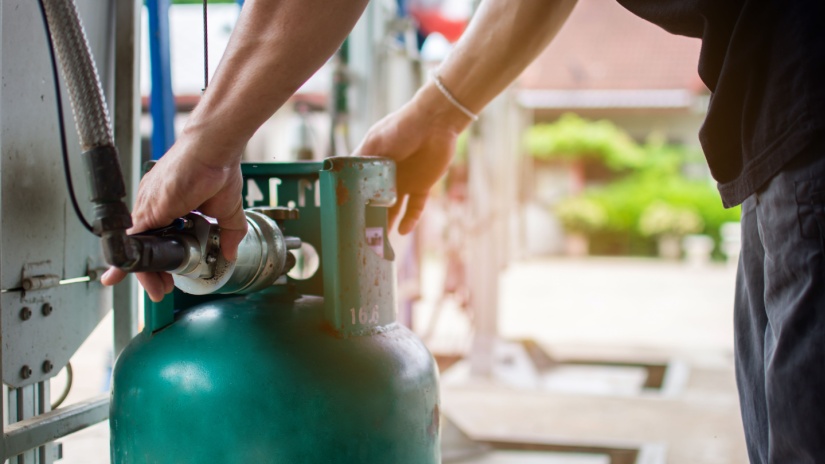Knowledge Centre
What LPG gas bottle sizes do you need?

If natural gas isn’t an option for your home, you might be thinking about switching to LPG (liquefied petroleum gas).
Before you make the switch, it's important to familiarise yourself with the various sizes of LPG gas bottles on the market.
Whether you need a small cylinder for occasional use or a larger tank for frequent, high-volume needs, understanding the different sizes can help you make an informed decision.
Here’s a guide to the available residential LPG gas bottle sizes to help you choose the right one for your needs.
LPG gas bottle sizes
LPG gas bottles come in a range of sizes to suit different needs, from compact options for occasional use to larger tanks for more demanding applications. The sizes of LPG bottles can start at 3.7 kg and go up to 210 kg, offering flexibility depending on your consumption.
Here’s a detailed table outlining the various LPG gas bottle sizes available in Australia, including their capacities, dimensions, and weights:
| LPG gas bottle sizes | LPG gas bottle capacity (litres) | Height (cm) | Diameter (cm) | Empty weight (KG) |
| Small (5KG) | 11 | 40 | 26 | 6.5 |
| Small (9KG) | 23 | 50 | 31 | 9.5 |
| Medium (18KG) | 44 | 81.5 | 31 | 20-22 |
| Medium | 65 | 84 | 37.5 | 38 |
| Large (45KG) | 108 | 124 | 37.5 | 38 |
| Large (90KG) | 200 | 134 | 50.8 | 70 |
Understanding LPG gas bottle sizes
When choosing an LPG gas bottle for your home, business, or recreational needs, it's essential to understand the different sizes available and how each fits your energy usage.
LPG gas bottles vary in size, portability, and the amount of gas they hold, making it crucial to select the right one based on your specific requirements. Here's a breakdown of the different LPG gas bottle sizes:
Small LPG gas bottles
Small LPG gas bottles are ideal for light gas users and are perfect for portable applications. These bottles are typically used by households with moderate or seasonal gas consumption, including small families or individuals who primarily use gas for barbecues, camping trips, or patio heaters.
The most common sizes in this category include 4kg (3.7kg), 9kg (8.5kg), and 14kg (13.5kg).
| LPG gas bottle size | Key uses | Advantages | Considerations |
| Small LPG bottles (4KG, 9KG, 14KG) | Barbecues | Highly portable | Needs frequent refills |
| Camping stoves | Easy to refill/exchange | Limited capacity for larger households | |
| Patio heaters | Ideal of occasional/seasonal use |
Medium LPG gas bottles
Medium-sized LPG gas bottles are designed for households that rely on gas for daily essentials like cooking, heating, or hot water systems.
Common sizes for medium cylinders range from 45kg to 90kg, offering a larger gas capacity that suits more frequent usage.
| LPG gas bottle size | Key uses | Advantages | Considerations |
| Medium LPG gas bottles (45KG, 90KG) | Domestic cooking | Larger capacity reduces the need for frequent refills | Less portable due to size |
| Heating systems | Suitable for daily household use | Must be professionally installed | |
| Hot water systems | Supports multiple gas appliances |
Large LPG gas bottles
Large LPG gas bottles, often referred to as LPG tanks, are designed to cater to high gas consumption needs. They are typically used in larger households or by commercial establishments, such as restaurants or industrial businesses, that require a substantial and constant supply of gas.
These tanks range from 190kg to over 2,100kg and are installed outside homes or businesses.
| LPG gas bottle size | Key uses | Advantages | Considerations |
| Large LPG bottles (190KG, 2,100KG+) | Central heating | Continuous and reliable gas supply | Installation space needed outside the property |
| Industrial kitchens | Ideal for high gas use in large homes or businesses | Higher upfront costs | |
| Heavy duty gas applications | Refills are handled via delivery service | Regular maintenance required |
Factors to consider when choosing LPG gas bottle sizes
Gas usage
The most important factor when picking an LPG gas bottle size is how much gas your household uses. If you only use gas occasionally for cooking or barbecuing, a smaller bottle will do the job.
However, if you rely on gas for daily cooking, heating, and hot water, you’ll need a larger bottle to avoid constant refills. The more appliances that run on gas, the bigger your bottle should be.
Available space
Before selecting a bottle size, check how much outdoor space you have for storing it. Smaller gas bottles are compact and easy to store, making them perfect for homes with limited room.
Larger bottles, such as those over 45kg, need a dedicated space outside your home, and they also require proper ventilation and safe distance from windows or entry points.
Budget and cost
Cost is another factor when choosing the right gas bottle. Smaller bottles have a lower upfront cost, but they need to be refilled more often, which can add up over time.
Larger tanks, while more expensive initially, tend to be more cost-effective in the long run as they require fewer refills. You’ll also want to factor in delivery fees for refills and consider any installation costs for larger tanks.
Convenience and portability
If portability is important to you, for example, if you’re using the gas for camping or moving it around for outdoor activities, a smaller LPG bottle is much more convenient.
Larger bottles are heavier and must remain in a fixed location, making them better suited for more permanent, high-usage setups like home heating.
Frequency of use
Think about how often you use gas. If it's only on occasion, such as for weekend barbecues or seasonal heating, a small to medium bottle will likely meet your needs.
However, if gas powers most of your home’s energy needs year-round, opting for a bigger tank will be more practical and reduce the inconvenience of frequent refills.
Safety regulations
Finally, always consider local safety regulations when installing LPG gas bottles. Some areas may have specific rules about where and how bottles can be stored, especially larger ones.
Ensuring your installation meets safety standards is crucial for long-term use and peace of mind.
What does a gas bottle cost?
A 45kg LPG gas bottle typically costs between $120 and $160, but you may also need to factor in an annual rental fee, which can add an extra $40 to $50 each year.
Several things affect the price of an LPG bottle, including:
- The size of the gas bottle
- The current price of fuel
Smaller LPG bottles, like 4kg ones used for barbecues or outdoor heaters, can be found at stores like Bunnings or petrol stations for around $39.89. For larger 8-9kg bottles, prices usually range between $35 and $80.
Remember, refilling smaller LPG bottles at nearby refill stations is often a more affordable option than buying a new one each time.
How long does a 45kg gas bottle last?
A 45kg LPG gas bottle typically lasts a family of four in a three-bedroom home around 4 to 6 weeks before needing a replacement. However, the exact time can vary depending on how much gas you use for things like cooking, heating, and hot water.
LPG suppliers usually deliver 45kg gas bottles. When one bottle runs out, you simply contact your supplier for a replacement. Most suppliers provide two 45kg bottles, so you always have a backup, ensuring you won’t run out of gas unexpectedly.
Is LPG gas cheaper than mains gas?
LPG can be cheaper than natural gas, especially for homes with low to moderate gas usage. This is because LPG contains more energy per unit, meaning you need less of it to achieve the same results as natural gas. Over time, this efficiency can make LPG a more cost-effective option.
For example, LPG is often cheaper for things like:
- Barbecues
- Outdoor heaters
- Short showers
- Using cold water for laundry
- Homes where gas cooking is infrequent or where there's no gas stove.
Natural gas also comes with a daily supply charge just for staying connected to the network, even if you use little gas. With LPG, you only pay for what you use, and since it’s not tied to the mains network, there are no daily fees. For households with light gas usage, this makes LPG a more affordable choice than natural gas.
Is LPG suitable for my home? Call Compare Energy!
LPG can be a great choice depending on your location, how much gas you use, and the prices available to you.
For rural areas or homes without access to natural gas mains, LPG is an excellent alternative. It's denser and more efficient than natural gas, meaning you can achieve similar results while using less fuel overall.
If you're trying to cut costs, LPG can be a budget-friendly option, especially if your household has low to moderate gas consumption.
Even if your home is connected to natural gas, you might still consider LPG for outdoor uses like barbecues or patio heaters.
If you're thinking about setting up LPG at your home or want more information about switching, our Compare Energy team can help you find an LPG supplier that fits your needs. Call today on 1300 790 106 for more details.

